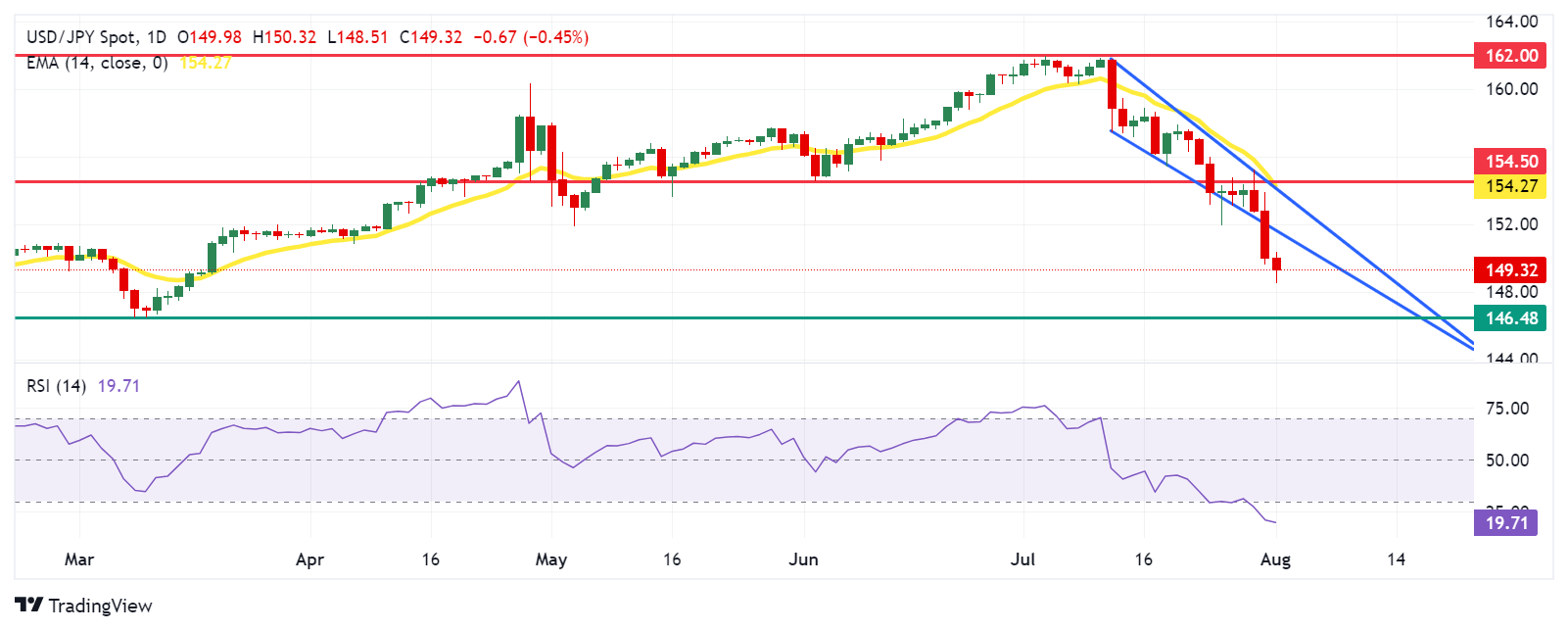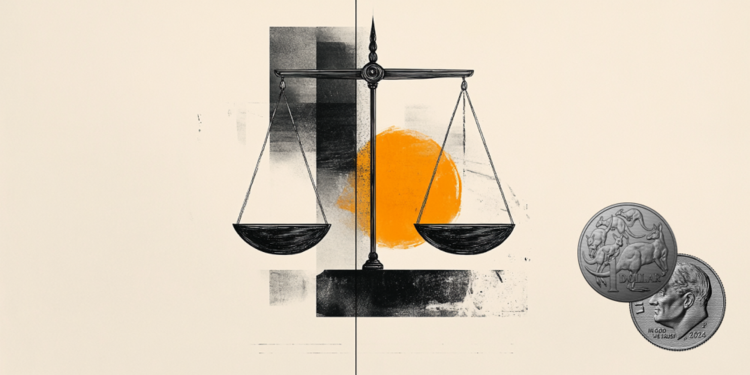- The Japanese Yen is gaining ground following unexpected hawkish policy announcements from the BoJ.
- Japan’s Finance Ministry said officials spent 5.53 trillion yen ($36.8 billion) in July to stabilize the yen.
- The US dollar weakened after the Fed kept rates at 5.25%-5.50% on Wednesday.
The Japanese Yen (JPY) continues to rise against the US Dollar (USD) for the third consecutive session, hitting a four-month high of 148.50 on Thursday. This rise is linked to the Bank of Japan’s (BoJ) unexpectedly hawkish policy announcements.
The Bank of Japan raised its short-term rate target by 15 basis points (bps), raising it to a range of 0.15%-0.25% from 0%-0.1% previously. In addition, the bank outlined a plan to reduce its purchases of Japanese government bonds (JGBs) to 3 trillion yen per month, starting in the first quarter of 2026.
Reuters reported on Wednesday that Japan’s Finance Ministry confirmed suspicions of market intervention by authorities. In July, Japanese officials spent 5.53 trillion yen ($36.8 billion) to stabilize the yen, which had fallen to its lowest level in 38 years.
The USD/JPY pair fell as the US dollar struggled after the Federal Reserve (Fed) decided to hold rates at 5.25%-5.50% during its July meeting on Wednesday. Traders will look for further guidance in upcoming US economic data, including the ISM manufacturing PMI and weekly initial jobless claims, due later on Thursday.
Daily Market Wrap: Japanese Yen Extends Rally Following Surprise BoJ Rate Hike
- Federal Reserve Chairman Jerome Powell said during a news conference that a rate cut in September is “on the table.” Powell added that the central bank will closely monitor the labor market and remain vigilant for signs of a possible sharp slowdown, according to Reuters.
- BoJ Governor Kazuo Ueda said it was appropriate to adjust the degree of easing to sustainably and stably achieve the 2% inflation target. He also stressed that interest rates will continue to rise. In addition, Japan’s largest lender Mitsubishi UFJ Bank announced that it will raise its short-term prime rate to 1.625% from 1.475% from Sept. 2, aligning with the BoJ’s rate hike, according to Reuters.
- Assessing the BoJ’s policy outlook going forward, “The BoJ’s policy statement includes a broadly optimistic assessment of Japan’s economic outlook, stating that fixed investment is ‘on a moderately rising trend’ and corporate profits are ‘improving,’” Rabobank analysts said, adding: “It states that wage increases ‘have spread across regions, industries and firm sizes. ’ This leaves the door open for further rate hikes potentially in late 2024 or early 2025.”
- U.S. private-sector employment rose by 122,000 in July and annual wages rose 4.8% year-over-year, Automatic Data Processing (ADP) reported on Wednesday. This reading followed an increase of 155,000 (revised from 150,000) recorded in June and was below the market expectation of 150,000.
- Japan’s retail sales rose 3.7% year-on-year in June, beating the forecast 3.3% increase and hitting the highest level in four months. Meanwhile, on a monthly basis, retail sales rose 0.6%, a slowdown compared with the previous increase of 1.7%.
- Japan’s unemployment rate was 2.5% in June, slightly lower than market forecasts of 2.6% and the rate seen in the previous four months. This marks the lowest unemployment rate since January.
- Atsushi Mimura, Japan’s newly appointed Vice Finance Minister for International Affairs and top foreign exchange official, said in an interview with Bloomberg on Monday that “while the recent depreciation of the yen has both advantages and disadvantages, the drawbacks are becoming more noticeable.” Mimura said intervention is one of the measures available to counter excessive speculation affecting the currency.
Technical Analysis: USD/JPY moves below 150.00
The USD/JPY is trading around 149.30 on Thursday. The daily chart analysis shows that the pair has broken below the falling wedge pattern, suggesting that the downtrend is continuing rather than reversing. Moreover, the 14-day Relative Strength Index (RSI) is below 30, suggesting an oversold situation for the currency and a possible near-term bounce.
The USD/JPY pair could test support around a four-month low of 146.48 recorded in March.
On the upside, the USD/JPY pair could find resistance near the lower boundary of the falling wedge at 151.60. If the pair turns back into this wedge, it could weaken the extended downtrend and set the stage for a possible bullish reversal. The pair could then test the upper boundary of the wedge, which aligns with the 14-day exponential moving average (EMA) at 154.27 and the “pullback support turned resistance” at 154.50.
USD/JPY: Daily Chart
Japanese Yen PRICE Today
The table below shows the Japanese Yen (JPY) exchange rate against major currencies today. The Japanese Yen was the strongest currency against the Australian Dollar.
| USD | EUR | GBP | JPY | CAD | AUD | NZD | CHF | |
|---|---|---|---|---|---|---|---|---|
| USD | -0.07% | -0.01% | -0.37% | -0.03% | 0.15% | -0.07% | -0.12% | |
| EUR | 0.07% | 0.06% | -0.32% | 0.04% | 0.23% | 0.00% | -0.05% | |
| GBP | 0.01% | -0.06% | -0.38% | -0.02% | 0.17% | -0.05% | -0.10% | |
| JPY | 0.37% | 0.32% | 0.38% | 0.36% | 0.54% | 0.27% | 0.23% | |
| CAD | 0.03% | -0.04% | 0.02% | -0.36% | 0.19% | -0.04% | -0.09% | |
| AUD | -0.15% | -0.23% | -0.17% | -0.54% | -0.19% | -0.22% | -0.27% | |
| NZD | 0.07% | -0.01% | 0.05% | -0.27% | 0.04% | 0.22% | -0.05% | |
| CHF | 0.12% | 0.05% | 0.10% | -0.23% | 0.09% | 0.27% | 0.05% |
The heatmap shows percentage changes of major currencies. The base currency is selected from the left column, while the quote currency is selected from the top row. For example, if you choose the Japanese Yen from the left column and move along the horizontal line to the US Dollar, the percentage change shown in the chart will represent the JPY (base)/USD (quote).
Bank of Japan FAQs
The Bank of Japan (BoJ) is the Japanese central bank, which sets the country’s monetary policy. Its mandate is to issue banknotes and carry out monetary and foreign exchange control to ensure price stability, which means an inflation target of around 2%.
The Bank of Japan has been pursuing ultra-loose monetary policy since 2013 in order to stimulate the economy and fuel inflation amid a low-inflation environment. The bank’s policy is based on Quantitative and Qualitative Easing (QQE), or printing money to buy assets such as government or corporate bonds to provide liquidity. In 2016, the bank doubled down on its strategy and further relaxed policy by first introducing negative interest rates and then directly controlling the yield on its 10-year government bonds.
The Bank of Japan’s massive stimulus has caused the Yen to depreciate against its major currency peers. This process has been exacerbated more recently by a growing policy divergence between the Bank of Japan and other major central banks, which have opted to sharply raise interest rates to combat decades-high inflation. The Bank of Japan’s policy of keeping rates low has led to a widening spread with other currencies, dragging down the value of the Yen.
The weak yen and the surge in global energy prices have caused Japanese inflation to rise, exceeding the Bank of Japan’s 2% target. However, the Bank of Japan judges that a sustainable and stable achievement of the 2% target is still not in sight, so a sharp change in current monetary policy seems unlikely.
Source: Fx Street
I am Joshua Winder, a senior-level journalist and editor at World Stock Market. I specialize in covering news related to the stock market and economic trends. With more than 8 years of experience in this field, I have become an expert in financial reporting.








